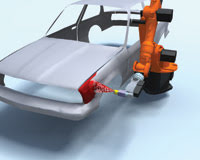Driven by computer gaming developments, the graphics processing unit (GPU) in a personal computer has become a very powerful device and is designed specifically for image handling operations. So image processing software suppliers such as Stemmer Imaging and Matrox are introducing GPU-based functions to perform a host of image processing tasks. Version 10 of Stemmer’s Common Vision Blox (CVB) harnesses the power of the PC’s GPU, independent of make and model, yielding a dramatic increase in the speed of the image processing algorithms. Matrox Imaging Library version 9.0 exploits the GPU for tasks such as colour space conversion, spatial and temporal filtering, and geometric transformations.
Mark Williamson of Firstsight Vision (a member of the Stemmer Imaging Group) says there is a need for yet more computing power in machine vision because of increased production speeds, more complex tasks, higher-resolution images and faster-frame-rate cameras.
Demand is outstripping Moore’s Law. It is now possible to program the GPU in Microsoft’s High Level Shading Language. Microsoft DirectX 10 incorporates the new concept Shader Model 4.0, a “unified shader” that makes all GPUs available for image processing. It compiles at run time, and it involves no compiler or software development kit costs. Processor-intensive imaging tasks such as Bayer-to-RGB conversion are carried out in the GPU by Shader functions within Stemmer’s CVB 10.

PhysVis combines factory modelling software with the PhysX chip set to develop “first time right” production systems. The paint spray particles are enlarged here to emphasize their physics-based modelling. Picture courtesy of SimX Ltd.
Meanwhile, a research project called PhysVis is leveraging the capability of the PhysX gaming chip set to bring physics-based dynamic modelling to powerful factory simulation software at a price accessible to small companies and subcontractors. Ageia Technologies developed the PhysX gaming chip set to produce on-screen movements that obey the rules of physics for computer games. The board works in conjunction with the processor and graphics card in the host PC to render simultaneously the movements and interactions of people, weapons, particles and fluids, as well as the surrounding landscape.
SimX Ltd. is combining the PhysX accelerator with Visual Components simulation software. Such software generally uses finite element analysis to model static problems, but dynamic challenges need real physics. For example, in spray painting, accurate viscosity, density, surface tension and drying-time data allow the software to model the coverage and wastage of the paint. The process engineer can interact with the simulation to devise a procedure that optimises paint quality while minimizing the amount that runs away, improving the cost-effectiveness of the process.